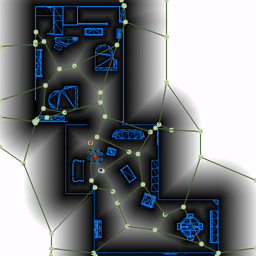ABSTRACT:
We present techniques for fast motion planning by using discrete approximations
of generalized Voronoi diagrams, computed with graphics hardware. Approaches
based on this diagram computation are applicable to both static and dynamic
environments of fairly high complexity. We compute a discrete Voronoi
diagram by rendering a three-dimensional distance mesh for each Voronoi
site. The sites can be points, line segments, polygons, polyhedra, curves
and surfaces. The computation of the generalized Voronoi diagram
provides fast proximity query toolkits for motion planning. The tools
provide the distance to the nearest obstacle stored in the Z-buffer, as
well as the Voronoi boundaries, Voronoi vertices and weighted Voronoi graphs
extracted from the frame buffer using continuation
methods. Our approaches
are not only applicable to classical motion planning problems, but are
also suitable for dynamic environments and sensor-based planning. We have
implemented these algorithms and demonstrated their performance for path
planning in a complex dynamic environment composed of more
than 140,000 polygons.
|

